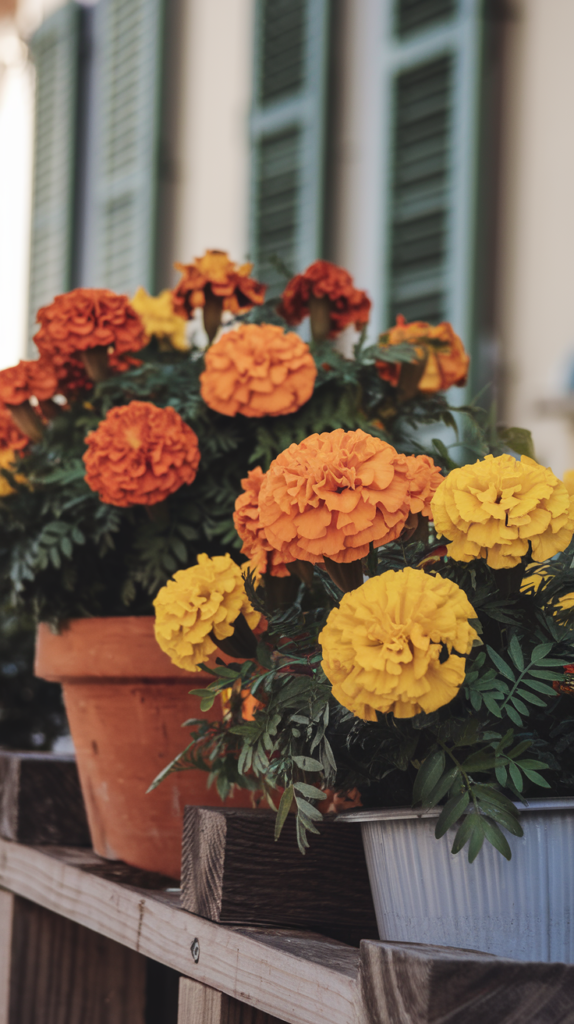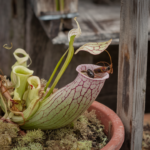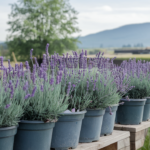Marigolds are one of the easiest and most rewarding flowers to grow in pots. Their bright blooms, pest-resistant properties, and ability to thrive in various conditions make them a favorite among gardeners. Whether you are growing marigolds for their vibrant colors, their ability to repel pests, or their symbolic meaning, this guide will help you successfully cultivate them in containers.
Choosing the Right Marigold Variety
Marigolds come in several varieties, and choosing the right one for your potted garden is essential.
The three most common types include French Marigolds (Tagetes patula), which are compact plants ideal for pots, growing between 6-12 inches tall. They produce small, bushy flowers in shades of red, orange, and yellow. They are perfect for small containers and are well-suited for decorative arrangements due to their manageable size and continuous blooming.
African Marigolds (Tagetes erecta) are taller and more robust, growing up to 3 feet. Their large, pom-pom-like blooms make them a stunning centerpiece in large pots. They require more space but reward gardeners with dramatic, eye-catching flowers that last throughout the season.
Signet Marigolds (Tagetes tenuifolia) have delicate, small flowers and finely divided foliage, growing about 12 inches tall, making them a great choice for small containers or as decorative accents. Their feathery leaves and edible flowers add both beauty and practicality to your garden, as they can be used as garnishes in salads and other dishes.
Choosing the Right Container

Marigolds adapt well to different containers, but some factors will improve their growth and longevity.
The size of the pot is important. It should be at least 6-8 inches deep for French marigolds and 12 inches or deeper for African marigolds. Deeper pots allow room for root expansion and promote healthier plant development.
Drainage is also crucial, so ensure the pot has adequate drainage holes to prevent waterlogging. Excess moisture can cause root rot, which is a common issue when growing marigolds in containers.
Regarding material, terracotta, ceramic, plastic, or wooden pots all work well, but avoid those that retain too much moisture, as marigolds prefer well-draining soil. Terracotta pots are especially great because they allow excess moisture to evaporate, reducing the risk of fungal infections.
Selecting the Right Soil
Marigolds thrive in loose, well-draining soil. A high-quality potting mix with good aeration is best. Adding perlite or sand can help improve drainage and prevent compaction.
It is important to avoid using heavy garden soil, as it can become compacted and hinder root growth. Instead, use a light potting mix enriched with organic matter to provide essential nutrients while maintaining the right texture for root expansion.
Planting Marigolds in Pots
You can grow marigolds from seeds or transplants. Seeds take about 7-14 days to germinate and bloom in 8-10 weeks. If you prefer faster results, purchasing young marigold plants from a nursery and transplanting them into your container is a great option.
To sow seeds, fill the pot with moist potting mix, leaving about an inch of space at the top. Sprinkle the seeds evenly over the soil surface, then lightly cover them with a thin layer of soil about ¼ inch deep. Water gently to moisten the soil without washing away the seeds. Place the container in a warm, sunny spot to encourage germination.
If transplanting seedlings, gently remove them from their original containers. Loosen the roots slightly and place them in the prepared pot, ensuring they sit at the same depth as in their previous container. Fill in with soil, pressing lightly around the plant base, and water thoroughly after planting. Spacing the seedlings properly allows them to develop well and prevents overcrowding, which can lead to poor air circulation and disease.
Providing the Right Growing Conditions
Marigolds love sunlight and require at least 6-8 hours of direct sun daily. Placing your pots in a location that gets plenty of sun, such as a south-facing balcony, patio, or windowsill, will ensure healthy growth.
Watering should be done carefully to keep the soil evenly moist but not waterlogged. Overwatering can cause root rot, so it is best to water deeply when the top inch of soil feels dry. Avoid overhead watering to prevent fungal diseases and instead water at the base of the plant to keep the leaves dry.
Marigolds thrive in warm temperatures between 70-85°F (21-29°C). They can tolerate heat but should be protected from extreme drought conditions. During hot summer months, consider mulching the top layer of soil to help retain moisture while preventing excessive evaporation. Young plants are sensitive to frost, so avoid exposing them to cold temperatures.
Fertilizing Marigolds in Pots
Marigolds are not heavy feeders, but occasional feeding helps them produce more blooms. Using a balanced liquid fertilizer with a 10-10-10 or 20-20-20 ratio every 2-4 weeks is recommended. This provides the necessary nutrients to encourage strong stems and vibrant flowers.
Excessive nitrogen should be avoided, as it encourages leafy growth at the expense of flowers. Organic alternatives such as compost tea or diluted fish emulsion can also be beneficial, as they supply nutrients in a slow-release form without overwhelming the plant.
Deadheading and Pruning
To encourage continuous blooming, deadhead spent flowers regularly by pinching or cutting them off. This prevents seed formation and redirects energy into producing new blooms, keeping your marigolds looking fresh and vibrant throughout the season.
If plants become leggy, trimming back overgrown stems will help maintain a bushy shape. Cutting back excessive growth also improves airflow around the plant, reducing the risk of fungal infections.
Managing Pests and Diseases
Marigolds are known for their pest-resistant properties, but they can still encounter some issues.
Common pests include aphids, which suck sap from leaves. These can be managed by spraying the plants with a gentle soap-water solution. Spider mites cause yellowing leaves, and increasing humidity or rinsing the foliage with water can help control them. Slugs and snails may also be a problem, and they can be removed by handpicking or using diatomaceous earth around the base of the pot.
Diseases such as powdery mildew, which appears as a white powder on leaves, can be prevented by improving air circulation and avoiding overhead watering. Root rot can occur due to overwatering, so ensuring pots have proper drainage is essential. Leaf spot, which causes brown or yellow spots on leaves, may indicate fungal issues. Removing affected leaves and applying a mild fungicide can help control the spread.
Overwintering Marigolds in Pots
Marigolds are typically grown as annuals, but you can extend their life by bringing them indoors before the first frost. Place the pots in a sunny indoor location with temperatures above 50°F (10°C). Reduce watering but do not let the soil dry out completely. Alternatively, you can collect seeds from dried flower heads to plant next season.
Companion Planting with Marigolds
Marigolds are excellent companion plants for vegetables and herbs, as they repel nematodes, aphids, and other harmful insects while attracting pollinators. Planting them alongside tomatoes, peppers, and cucumbers helps deter pests naturally. They also work well around basil and mint for added insect protection. However, they should not be planted too close to beans, as they may hinder their growth.
Conclusion
Growing marigolds in pots is an easy and rewarding experience, offering vibrant blooms and natural pest control. By selecting the right variety, providing proper sunlight, watering correctly, and maintaining good soil conditions, you can enjoy beautiful marigolds throughout the season. With minimal effort, these cheerful flowers will brighten up your home, balcony, or garden space!


